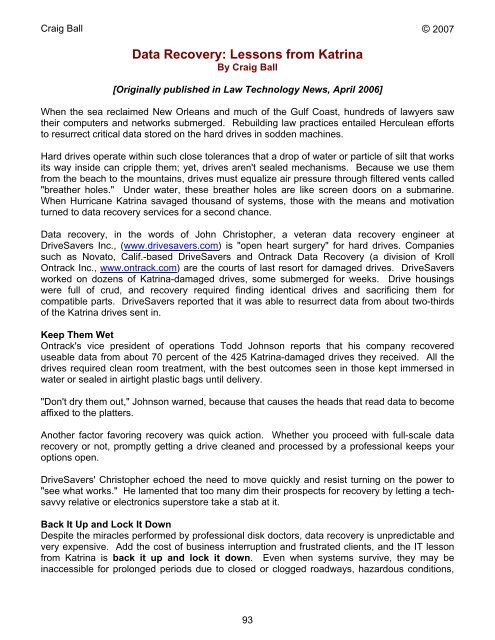Six Articles on Electronic - Craig Ball
Six Articles on Electronic - Craig Ball
Six Articles on Electronic - Craig Ball
Create successful ePaper yourself
Turn your PDF publications into a flip-book with our unique Google optimized e-Paper software.
<strong>Craig</strong> <strong>Ball</strong> © 2007<br />
Data Recovery: Less<strong>on</strong>s from Katrina<br />
By <strong>Craig</strong> <strong>Ball</strong><br />
[Originally published in Law Technology News, April 2006]<br />
When the sea reclaimed New Orleans and much of the Gulf Coast, hundreds of lawyers saw<br />
their computers and networks submerged. Rebuilding law practices entailed Herculean efforts<br />
to resurrect critical data stored <strong>on</strong> the hard drives in sodden machines.<br />
Hard drives operate within such close tolerances that a drop of water or particle of silt that works<br />
its way inside can cripple them; yet, drives aren't sealed mechanisms. Because we use them<br />
from the beach to the mountains, drives must equalize air pressure through filtered vents called<br />
"breather holes." Under water, these breather holes are like screen doors <strong>on</strong> a submarine.<br />
When Hurricane Katrina savaged thousand of systems, those with the means and motivati<strong>on</strong><br />
turned to data recovery services for a sec<strong>on</strong>d chance.<br />
Data recovery, in the words of John Christopher, a veteran data recovery engineer at<br />
DriveSavers Inc., (www.drivesavers.com) is "open heart surgery" for hard drives. Companies<br />
such as Novato, Calif.-based DriveSavers and Ontrack Data Recovery (a divisi<strong>on</strong> of Kroll<br />
Ontrack Inc., www.<strong>on</strong>track.com) are the courts of last resort for damaged drives. DriveSavers<br />
worked <strong>on</strong> dozens of Katrina-damaged drives, some submerged for weeks. Drive housings<br />
were full of crud, and recovery required finding identical drives and sacrificing them for<br />
compatible parts. DriveSavers reported that it was able to resurrect data from about two-thirds<br />
of the Katrina drives sent in.<br />
Keep Them Wet<br />
Ontrack's vice president of operati<strong>on</strong>s Todd Johns<strong>on</strong> reports that his company recovered<br />
useable data from about 70 percent of the 425 Katrina-damaged drives they received. All the<br />
drives required clean room treatment, with the best outcomes seen in those kept immersed in<br />
water or sealed in airtight plastic bags until delivery.<br />
"D<strong>on</strong>'t dry them out," Johns<strong>on</strong> warned, because that causes the heads that read data to become<br />
affixed to the platters.<br />
Another factor favoring recovery was quick acti<strong>on</strong>. Whether you proceed with full-scale data<br />
recovery or not, promptly getting a drive cleaned and processed by a professi<strong>on</strong>al keeps your<br />
opti<strong>on</strong>s open.<br />
DriveSavers' Christopher echoed the need to move quickly and resist turning <strong>on</strong> the power to<br />
"see what works." He lamented that too many dim their prospects for recovery by letting a techsavvy<br />
relative or electr<strong>on</strong>ics superstore take a stab at it.<br />
Back It Up and Lock It Down<br />
Despite the miracles performed by professi<strong>on</strong>al disk doctors, data recovery is unpredictable and<br />
very expensive. Add the cost of business interrupti<strong>on</strong> and frustrated clients, and the IT less<strong>on</strong><br />
from Katrina is back it up and lock it down. Even when systems survive, they may be<br />
inaccessible for prol<strong>on</strong>ged periods due to closed or clogged roadways, hazardous c<strong>on</strong>diti<strong>on</strong>s,<br />
93













